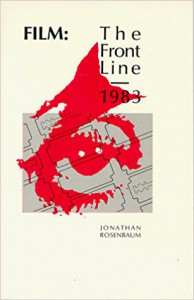My book Film: The Front Line 1983 (Denver: Arden Press), intended by its editor-publisher to launch an annual series, regrettably lasted for only one other volume, by David Ehrenstein, after two other commissioned authors failed to submit completed manuscripts. Miraculously, however, this book remained in print for roughly 35 years, and now that it’s finally reached the end of that run (although some copies can still be found online), I’ve decided to reproduce more of its contents on this site, along with links and (when available) illustrations. I’m beginning with the book’s end, an Appendix subtitled “22 More Filmmakers,” which I’m posting here in three installments, along with links and (when available) illustrations. — J.R.

MAURIZIO NICHETTI is a name I happen to know strictly by chance. My last trip to Europe (and only trip to Italy) consisted of three days at the Venice Film Festival in 1979, where I was invited to participate in a conference devoted to Cinema in the Eighties. And as I noted in an account of that conference in the December 1979 American Film, one film that I happened to see during those three days, Maurizio Nichetti’s Ratataplan — a first feature with an onomatopoeic title based on the sound of a drum cadence — may have actually suggested more about the subject of the conference than any of the lectures I heard. Read more
My book Film: The Front Line 1983 (Denver: Arden Press), intended by its editor-publisher to launch an annual series, regrettably lasted for only one other volume, by David Ehrenstein, after two other commissioned authors failed to submit completed manuscripts. Miraculously, however, this book remained in print for roughly 35 years, and now that it’s finally reached the end of that run (although some copies can still be found online), I’ve decided to reproduce more of its contents on this site, along with links and (when available) illustrations. I’m beginning with the book’s end, an Appendix subtitled “22 More Filmmakers,” which I’m posting here in three installments, along with links and (when available) illustrations. — J.R.

PAULA GLADSTONE. In Gladstone’s mainly black-and-white, hour-long, Super-8 The Dancing Soul of the Walking People (1978), possession and. dispossession both happily become very much beside the point. Shot over a two-year period, 1974-1976, each time the filmmaker went home to Coney Island (“I’d take my camera out and walk from one end of the land to the other,” she reports in Camera Obscura [No. 6]; “I’d talk to people on the streets and film them”), The Dancing Soul of the Walking People is basically concerned with the space underneath a boardwalk, a little bit like the luminous insides of a translucent zebra on a sunny day — an interesting kind of space, at once public and private, that is traversed by receding strips of light, camera pans, and people, in fairly continuous processions and/or rhythmic patterns. Read more
My book Film: The Front Line 1983 (Denver: Arden Press), intended by its editor-publisher to launch an annual series, regrettably lasted for only one other volume, by David Ehrenstein, after two other commissioned authors failed to submit completed manuscripts. Miraculously, however, this book remained in print for roughly 35 years, and now that it’s finally reached the end of that run (although some copies can still be found online), I’ve decided to reproduce more of its contents on this site, along with links and (when available) illustrations. I’ll begin with the book’s end, an Appendix subtitled “22 More Filmmakers,” which I’ll post here in three installments, along with links and (when available) illustrations. — J.R.

APPENDIX: 22 MORE FILMMAKERS
All sorts of determinations have led to the choices of the individual subjects of the 18 previous sections — some of which are rational and thus can be rationalized, and some of which are irrational and thus can’t be. To say that I could have just as easily picked 18 other filmmakers would be accurate only if I had equal access to the films of every candidate. Yet some of the arbitrariness of the final selection — particularly in relation to the vicissitudes of American distribution and other kinds of information flow — has to be recognized. Read more




